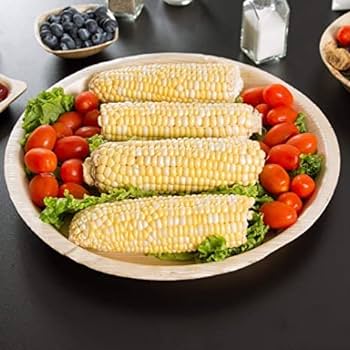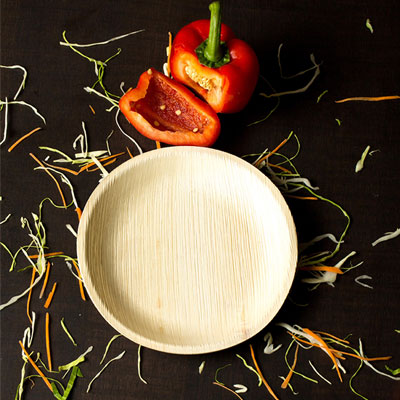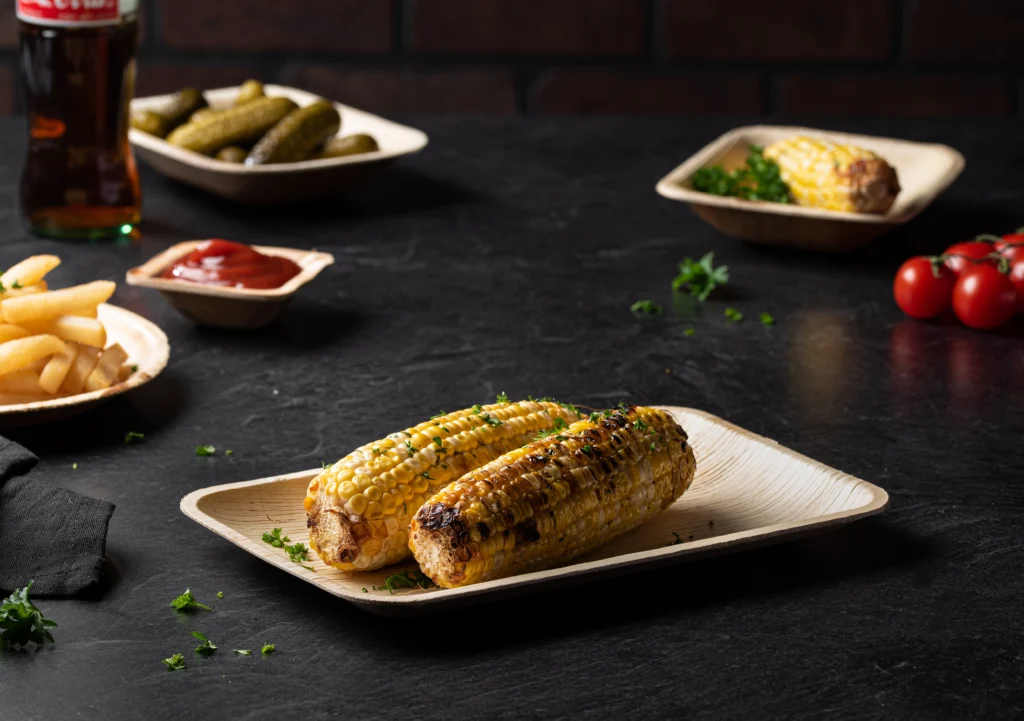Explore the eco-friendly and stylish choice of Palm Leaf Plates for your dining. Discover how they combine sustainability, durability, and aesthetic appeal to elevate any meal. Perfect for any occasion!
Introduction to Palm Leaf Plates
In an era where environmental sustainability is more than just a buzzword, it’s imperative to make conscious choices in every aspect of our lives, including the tableware we use. Among the eco-friendly options available, palm leaf plates stand out for their unique blend of sustainability, durability, and aesthetic appeal. But what are palm leaf plates, and why are they becoming increasingly popular?
Table of Contents
What Are Palm Leaf Plates?
Palm leaf plates are eco-friendly, biodegradable tableware made from the fallen leaves of the Areca palm tree. These plates are produced through a sustainable process that involves collecting naturally shed leaves, which are then cleaned, heat-pressed, and shaped into various sizes and forms of plates, bowls, and trays. This method does not require the cutting down of trees, nor does it involve any chemicals or synthetic materials, making palm leaf plates a completely natural and environmentally friendly alternative to traditional plastic or paper tableware.
The process of making palm leaf plates is relatively simple but effective. After the leaves are collected, they are soaked in water to clean them, then they are heat-pressed into molds. This not only forms the plates but also sterilizes them, making them safe for food contact. Once pressed, the edges are trimmed to create a smooth finish. The result is a sturdy, lightweight, and compostable plate that can handle hot, cold, wet, or oily foods without bending, breaking, or imparting any taste to the food.
Palm leaf plates are appreciated not only for their environmental benefits but also for their unique, natural look. Each plate has its own distinctive pattern, texture, and color, which can add a rustic and elegant touch to dining experiences. They are suitable for all types of events, from casual barbecues to formal weddings, and are increasingly popular among those seeking sustainable and disposable tableware solutions.

The Benefits of Using Palm Leaf Plates
1. Eco-Friendly and Biodegradable
One of the most significant benefits of palm leaf plates is their eco-friendliness. Made from naturally fallen leaves, these plates are entirely biodegradable and compostable, breaking down in a matter of months without leaving any harmful residues in the environment. This stands in stark contrast to plastic or Styrofoam options, which can take hundreds of years to decompose and contribute significantly to land and marine pollution.
2. Sustainable Production
The production process of palm leaf plates is sustainable and does not harm the environment. No trees are cut down to manufacture these plates; instead, they are made from leaves that would otherwise go to waste. This not only helps in reducing waste but also ensures that the production process has a minimal carbon footprint.
3. Chemical-Free
Palm leaf plates are produced without the use of chemicals, making them a safer alternative for serving food. Unlike some disposable tableware that can leach chemicals into food, especially when heated, palm leaf plates are natural and free from any synthetic substances.
4. Durable and Versatile
Despite their natural origins, palm leaf plates are surprisingly sturdy and can comfortably hold hot, cold, wet, or oily foods without getting soggy or breaking. This makes them suitable for a wide range of dishes and occasions, from outdoor barbecues to elegant wedding receptions.
5. Unique Aesthetic Appeal
Each palm leaf plate has a unique pattern, texture, and color, adding a touch of rustic elegance to any dining experience. Their natural beauty is often appreciated by guests and can enhance the overall presentation of food, making them perfect for events where aesthetics are important.
6. Microwave and Oven Safe
Unlike some disposable alternatives, palm leaf plates can safely be used in the microwave and oven for warming food, up to a certain temperature. This versatility is a significant advantage for both home use and for caterers who need to keep food warm.
7. Complements Various Themes
The natural and earthy look of palm leaf plates complements a wide range of décor themes, from rustic to tropical to eco-chic. They are an excellent choice for environmentally themed events, outdoor parties, or any occasion where sustainability is valued.
8. Convenient and Hygienic
For events or situations where washing dishes is impractical, palm leaf plates offer a convenient and hygienic solution. They are single-use, eliminating the need for cleaning and significantly reducing the risk of cross-contamination.
9. Supports Rural Livelihoods
The production of palm leaf plates often provides valuable income for rural communities where economic opportunities may be limited. By choosing these products, consumers can support sustainable livelihoods and contribute to the economic well-being of these communities.
Comparing Palm Leaf Plates to Other Options
Palm Leaf Plates vs. Plastic Plates
Environmental Impact: Palm leaf plates offer a significant environmental advantage over plastic plates. They are biodegradable and compostable, breaking down naturally without harming the ecosystem. Plastic plates, made from petroleum-based polymers, contribute to long-term pollution and can take hundreds of years to decompose, often releasing toxic chemicals in the process.
Health Safety: Palm leaf plates are free from chemicals and toxins that can leach into food from plastic plates, especially under heat. This makes them a safer option for serving food, particularly hot or acidic dishes.
Aesthetics and Experience: Palm leaf plates have a unique, natural look that can enhance the dining experience, especially for eco-themed events or rustic settings. Plastic plates, while versatile in design, lack the same organic appeal and often feel less premium.

Palm Leaf Plates vs. Paper Plates
Sustainability: Both options are biodegradable, but palm leaf plates are often seen as more sustainable because they utilize fallen leaves that would otherwise go unused, without the need for tree cutting or extensive manufacturing processes. Paper plate production typically involves deforestation and more water and energy consumption.
Durability: Palm leaf plates are generally more sturdy and heat-resistant than paper plates, making them suitable for a wider variety of foods, including those that are hot, wet, or oily. Paper plates can become soggy or break down more easily with certain types of food.
Visual Appeal: Palm leaf plates provide a distinct, natural aesthetic that paper plates, often bleached and plain, cannot match. This makes palm leaf plates a more visually appealing option for special occasions.
Palm Leaf Plates vs. Ceramic or Glassware
Convenience for Events: Ceramic or glassware requires cleaning and is prone to breakage, making them less convenient for large or outdoor events. Palm leaf plates offer the benefit of being disposable, significantly reducing cleanup time and effort while still providing an elegant presentation.
Environmental Consideration: While ceramic or glassware is reusable and can be more eco-friendly over its lifetime, the energy and resources required to produce, wash, and transport these items can be considerable. Palm leaf plates, being compostable and made from a renewable resource, offer a low-impact alternative for occasions where disposable options are preferred.
Cost and Accessibility: Palm leaf plates can be more cost-effective for single-use scenarios, especially when considering the logistics and labor of using, transporting, and cleaning ceramic or glassware. They offer a practical, yet environmentally conscious choice for event organizers.
How to Choose the Right Palm Leaf Plates
1. Consider the Event or Usage
- Type of Event: For formal events, look for high-quality, aesthetically pleasing palm leaf plates with a uniform appearance. Casual events or outdoor gatherings might allow for more variety in shapes and textures.
- Food Type: Ensure the plates you choose are suitable for the type of food you’ll serve. Palm leaf plates are generally good for hot, cold, wet, or oily foods, but the size and shape of the plate should match the meal presentation.
2. Size and Shape
- Plates come in various sizes and shapes, including round, square, and rectangular. Think about the meals you’ll serve; for instance, larger plates are better for main courses, while smaller plates or bowls may be ideal for appetizers or desserts.
- Shape can also play a part in presentation. Choose a shape that complements your table setting or theme.

3. Quality and Durability
- Check for Thickness: Higher-quality palm leaf plates are usually thicker, making them more durable and better able to withstand heavy or moist foods without bending or breaking.
- Surface Smoothness: A smooth surface indicates good quality and makes the plates more appealing for guests.
4. Sustainability Credentials
- Eco-certifications: Look for plates that have certifications or are verified by third-party organizations for their sustainability practices. This ensures that the products are genuinely eco-friendly and produced responsibly.
- Source of Materials: Consider companies that transparently share where and how their palm leaves are sourced to ensure the process is sustainable and does not harm local ecosystems.
5. Packaging
- Eco-friendly Packaging: Since you’re opting for palm leaf plates due to their eco-friendliness, it makes sense to choose a brand that uses minimal and recyclable or biodegradable packaging materials.
6. Price Point
- Compare Prices: While palm leaf plates can be more expensive than traditional disposable plates, prices can vary between brands. Consider buying in bulk for large events to get a better price per unit.
- Invest in Quality: Remember that the cheapest option isn’t always the best. Investing in higher-quality plates can enhance the dining experience and reduce the risk of plates breaking or leaking.
7. Reviews and Recommendations
- Read Customer Reviews: Look at what others are saying about the durability, aesthetic appeal, and overall quality of the palm leaf plates.
- Ask for Recommendations: If you know someone who has used palm leaf plates for their events, ask them for brand recommendations.
Incorporating Palm Leaf Plates into Your Lifestyle
For Daily Dining
- Elevate Everyday Meals: Use palm leaf plates for regular family dinners to add a rustic charm to your meals. It’s a simple way to make even the simplest meal feel special.
- Kids’ Snack Time: Given their sturdiness and chemical-free nature, palm leaf plates are excellent for kids’ snack times. They’re safe, and you won’t have to worry about broken dishes.
Special Occasions and Entertaining
- Eco-friendly Parties: For birthdays, anniversaries, or any celebration, palm leaf plates serve as a conversation starter about sustainability and eco-conscious living.
- Weddings and Large Events: Opt for palm leaf plates to add a unique, natural aesthetic to your event. They’re perfect for creating an eco-chic vibe that guests will remember.
Outdoor Activities
- Picnics and Barbecues: Palm leaf plates are lightweight and easy to transport, making them perfect for picnics, barbecues, or any outdoor gathering. Plus, their compostability means you can minimize waste during your outdoor adventures.
- Camping: Bring palm leaf plates on camping trips for a durable, eco-friendly option that won’t harm the environment.
Home Parties
- Themed Dinners: Use palm leaf plates for themed dinner parties, such as a tropical luau or a rustic farm-to-table meal, to enhance the thematic experience.
- Wine and Cheese Nights: Pair palm leaf plates with wooden boards for a stylish and sustainable presentation of cheeses, fruits, and charcuterie.
Advocacy and Education
- Gifts: Give sets of palm leaf plates as gifts to friends and family to spread awareness about sustainable living practices.
- Educational Opportunities: Use palm leaf plates as a tool to educate children and guests about sustainability, discussing how such products are made and why they are beneficial for the environment.
Practical Tips for Integration
- Stock Up: Keep a stack of palm leaf plates on hand for impromptu gatherings or for those nights when you just don’t feel like doing the dishes.
- Composting: If you have a compost bin, palm leaf plates can be added after use, turning your waste into nutrient-rich soil for your garden.
- Mix and Match: Don’t hesitate to mix palm leaf plates with your regular tableware for an eclectic, environmentally conscious table setting.

Conclusion
Palm leaf plates are more than just a sustainable choice; they’re a statement of care for the planet and a step towards a more environmentally responsible lifestyle. By choosing palm leaf plates, you’re not just selecting tableware; you’re supporting a greener future.
FAQs
- How long do palm leaf plates take to decompose? Palm leaf plates typically decompose in about 60 days, much faster than plastic or even paper plates.
- Can palm leaf plates be reused? While designed for single use, palm leaf plates can be gently wiped clean and reused for dry or less oily foods.
- Are palm leaf plates microwave safe? Yes, palm leaf plates can safely be used in the microwave for short periods, making them even more versatile.
- How are palm leaf plates made? Palm leaf plates are made by collecting fallen leaves, which are then cleaned, heat-pressed into shape, and trimmed. The process is completely natural and chemical-free.
- Why do palm leaf plates vary in color and texture? Since palm leaf plates are made from natural leaves, variations in color and texture are normal and add to their unique charm.
